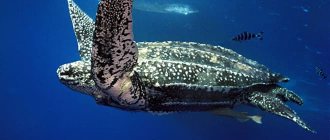Snails are found everywhere
Worldwide, the gastropod family contains approximately 70,000 different species. These include all land, sea and freshwater snails and slugs. Of these 70,000 species, about 5,000 live in seas, oceans, brackish and fresh waters; other species live on land.
Photo: Aquatic Arts
Depending on its habitat, the snail can be bright (yellow, orange, red) or inconspicuous (white, gray, brown).
Gastropods live everywhere, from the tropics to the Arctic and Antarctic. Many species of snails can live in the same habitat without competing with each other. This is possible because different species have different food preferences.
Keeping grape snails at home
Keeping a snail at home does not involve any difficulties, so anyone can cope with this task. The purchase of various devices, as well as housing, will not be so expensive.
Aquarium selection and filling
The best option for keeping snails at home is to have a container made of glass or plastic, while the bottom part should have sufficient area, and the container as a whole should have good ventilation. The bottom of the container is covered with a moistened mixture consisting of 6 parts earth and one part activated carbon. An important maintenance condition is to regularly clean the side surfaces and remove mucus from these surfaces. Optimal temperature conditions should be at 20-22 degrees during the day and about 19 degrees at night.
In any case, home conditions must correspond to natural living conditions. Living plants that can be securely fixed in the ground will not interfere with the aquarium.
In addition, the container should have a small pond in which the snails could swim. A little moistened moss wouldn't hurt. To prevent the snail shell from losing its mechanical strength, there should be a little limestone in the container. Naturally, such a container must be tightly closed, otherwise its inhabitants will find themselves outside of this container without much effort. In this case, holes must be made in the lid to ensure proper ventilation.
It is important to provide! The snail's habitat should not be dry and a high level of humidity is another important condition for keeping it at home. To do this, you need to regularly spray all the internal surfaces of the container, armed with a regular spray bottle. Spraying frequency – 2 times a day (morning and evening).
What does it eat?
The diet of a grape snail kept at home should include food components that are close to its natural habitat. Therefore, the snail can feed on various vegetation, including grass, leaves and even humus.
The most preferred plants are: wild strawberries, grapes, cabbage, nettles, burdock, lungwort, dandelion, plantain, as well as radish and horseradish. Feed should be fresh and juicy, containing a lot of moisture.
Care and hygiene, cleaning
The process of keeping a snail at home is also related to eliminating the possibility of damage to the shell. In addition, you should follow a number of rules, such as:
- Give snails exclusively fresh and high-quality food, providing them with a variety of nutritional components.
- Regularly feed the snails eggshells, as well as other food components with sufficient calcium content.
- Every day, or better yet in the evening, the walls of the terrarium are sprayed with clean water at room temperature.
- It is very important to control the level of humidity, not allowing the litter soil to dry out or become waterlogged.
- The water in the reservoir where the snails bathe is changed daily.
- Depending on the degree of contamination, the bedding soil is replaced. It can be replaced completely or partially.
- Housing for snails should not be installed in direct sunlight or near heating devices.
Maximum cleanliness in the container where grape snails are kept is the key to the health of these living creatures, since the chances of infecting them with nematodes or mites, as well as other harmful microflora, are reduced.
Snail breeding
By their nature, snails are hermaphrodite creatures, which are characterized by the presence of male and female genital organs. In order for a snail to lay eggs, it is necessary to exchange sex cells with other individuals. Snails can reproduce:
- From March to June.
- From the beginning of September to the beginning of October.
Male reproductive cells mature somewhat earlier. After transferring them to partners, the cells are stored in special seminal receptacles until the female reproductive cells mature.
The process of transferring germ cells lasts from several minutes to several hours. At this moment, the grape snails come into contact with each other, wrap their bodies around them or press against each other with the help of their soles.
After some time, the snails lay eggs, which are located in a special substance. Thanks to this substance, entire clusters or cocoons are formed. The offspring that are born have transparent shells consisting of a pair of turns. As they grow, the number of turns on the shell increases.
Grape snail as a pet // Clever Cricket
Most snails are herbivores
Freshwater snails feed mainly on algae growing on the surface of the substrate. Terrestrial individuals prefer leaves, lichens, fungi and rotting plant debris. Some species are omnivores and their diet consists of a variety of invertebrates and plants.
Snails and other gastropods feed using a radula. This mouthpart collects food from the surface of the substrate, acting like a conveyor belt to deliver nutritious morsels to the back of the mouth. The radula can have up to 14,000 miniature jagged projections! If the snail breaks off too large a piece of food, it can break it into smaller pieces by rubbing them against the hard plate on the roof of the mouth.
Different species of snails have radulas that are specially adapted for collecting and breaking down the main food products of that species.
Photo: Krzysztof Niewolny
Snails can make decisions
Snails have to survive in nature, so over a long period of evolution, gastropods have developed a number of adaptations to their environment. In captivity, these gastropods learn techniques useful for living in an aquarium.
Snails are much smarter than people think they are
In smart animals, neurons form many connections between parts of the brain. But all these contacts must work, otherwise the connections are destroyed. Eric Kandel studied the processes that occur during neuronal contacts while working with snails. Humans have too many neurons, about 86 billion, so this number makes research difficult. Aplysia only has a few of them, so studying the effect on learning and memory is much easier. During the experiment, Eric Kandel found that short-term memory is associated with an increase in the conductivity of existing synapses. Long-term memory is formed during the formation of new contacts between cells. These conclusions also apply to humans; nerve impulses pave their way to the brain in the same way in all organisms. Thus, the nervous processes occurring in snails helped to understand the complex contacts that are formed in the human central nervous system.
The habitat of snails depends on their species
Freshwater snails require specific environmental conditions to survive. The most important are the pH level of the water (also known as acidity) and the concentration of calcium carbonate in the water. Calcium carbonate is necessary for snails to form shells. Moreover, 45% of freshwater snails can be found in water with a calcium concentration of 20 mg/l or more. The remaining 55% of snails require a concentration of at least 3 mg/l. Where there is not enough calcium carbonate in the water to create shells, slugs appear.
The range of aquatic snails is wide, as they are often carried away by strong currents. Regions where water tends to dry out or freeze during the summer and winter months support only a few species of snails.
Land snails and other gastropods have adapted to all environments except air (we are not aware of flying snails). At night they come out to feed, and during the day they rest in protected places, for example, under stones. If conditions are too dry, the snail retreats into its shell, which it is able to seal: it can remain in this state for several months if necessary. During the winter, land snails usually hibernate. They are covered with a thick layer of mucus, which prevents water loss from the body. The dormant period ends when weather conditions improve.
The structure of the cochlea of the inner ear
Finally, let's talk about the person. We call the cochlea the organ of the inner ear, whose system is represented by a labyrinth. It, in turn, consists of a bone capsule and a membranous formation inside it.
Sections of the bony labyrinth:
- vestibule;
- actually, a snail;
- semicircular formations.
The cochlea is wrapped in a bone spiral of 2.5 turns in the ear around the bone rod. According to some scientists, its material is the strongest in the human body. The height of the organ is 5 mm, the width of its base is 9 mm.
Inside, the cochlea is divided into three regions by longitudinal lines of membranes. Perilymph is contained in the tympanic and scala vestibular organs, which communicate through the helicotherm at the apex of the cochlea. The middle scala contains endolymph. It is separated from the scala tympani by a basilar membrane with sensitive hairs, which is in contact with the tectorial membrane located above.
This entire device together is called the organ of Corti. This is where sound waves are converted into electrical nerve impulses.
The structure of snails - both animals and human organs - is striking in its volumetric content and the harmony of its relatively small size. To get to know him better is to once again be convinced of the genius of nature.
Snails appeared on our planet a long time ago. They have adapted to live in various environments and occupy certain niches in ecosystems. But how do gastropods manage to survive in difficult conditions? The brain is the most important organ that determines the relationship between the body and the environment, allowing it to adapt to new conditions and seek out new ways of survival.
Snails appeared on our planet a long time ago
The gastropod class has gone through a long evolutionary path, so its representatives carry the genetic experience of survival and pass it on to next generations. They have developed various adaptations to their environment. At the same time, animals demonstrate various biological improvements - sensory organs, legs for movement, structures for analyzing information and making decisions (brain, nerves, sensory organs). The nervous system helped them survive the struggle for existence and occupy a niche in which it was most comfortable to live.
Land and sea snails lay eggs, freshwater snails lay viviparous mollusks
Most terrestrial species have both female and male reproductive cells (they are hemaphroditic). They don't actually need to mate with another snail to reproduce because self-fertilization is possible. Parthenogenesis is especially important in areas where there are few partners. After mating, the females lay about 80 white eggs in a moist underground nest. Newly hatched snails have fragile shells and take about two years to mature.
Photo: Shutterstock
Some terrestrial gastropods “shoot” so-called “love arrows” at their potential partner. But this is rather an element of the mating dance that precedes the process of reproduction.
Most aquatic snails have male and female species. Freshwater females give birth to live young. Young animals look like smaller copies of adults. They develop quickly and mate at a young age to compensate for the lack of a larval stage.
But snails that live in the marine environment, like their terrestrial counterparts, lay fertilized eggs. They can lay eggs every month.
Shellfish in cooking
Shellfish and their caviar have long been used in cooking by chefs in many countries. The grape snail is a real exotic edible delicacy of French cuisine. For serving, restaurants use various sauces: garlic, cream, white wine and others. Serve large ones directly in the shells (without opening) along with onions and herbs. Small snails are used as a minor ingredient in soups and many main courses, such as stews or potatoes.
How many dishes to prepare? There are many recipes, as already noted. Grape snails can be fried in oil in a frying pan or in a slow cooker, baked in the oven, or boiled on the stove. Shellfish are marinated for a special barbecue, and also stuffed and canned.
Marinated, boiled, fried, baked snails make delicious salads, snacks for beer and other drinks, which are favored by all gourmets.
Snails are almost completely blind
In aquatic snails, the eyes are located directly on the head, and in terrestrial species, they are located on the top of long tentacles. The short tentacles are equipped with sensors of touch and smell. The snail uses them to search for food, since the eyes are almost completely blind.
Photo: ERROR 420
A keen sense of smell helps snails find food from just a few meters away, which is quite a long distance for an animal of such a tiny size.
Structure of sense organs
The sensory organs of this creature are unusual. These mollusks have practically no vision, it is difficult for them to distinguish even day from night, they have absolutely no hearing or the ability to make any sounds, but they have a sense of balance and a very acute sense of smell . The “nose” of a snail is its convex horns. They have all the same receptors as ordinary olfactory organs, only turned outward. Snails can smell food from several kilometers away.
The snail's body consists of three main parts: head, mantle and legs.
The leg is a fleshy muscle that extends from the bottom of the shell. By contracting the muscle, the cochlea moves along the surface in wave-like movements. Small species of snails move using the beating of eukaryotic cilia.
The mantle is the part of the snail that secretes the shell, a spiral shell. The mollusk uses the shell as a shelter in case of detection of danger. A snail's shell grows throughout its life. Chemically, it consists of calcium carbonate. Therefore, gastropods require a calcium-rich diet to provide a strong shell.
Some snail species have a second "door" on the shell, called the operculum, in addition to the main exit, from which the leg muscle protrudes.
Pet - Achatina
The structure of the Achatina snail, as well as its abilities, despite its apparent simplicity, have interesting features. Thus, they are characterized by long-term memory: Achatina can remember the location of food sources and return to them. Adults have a permanent place to rest; when the snail is moved to another place (within 30 meters), it will crawl back to its native, more familiar one. Young specimens are characterized by mobility and can cover long distances throughout the day; They also have the ability to migrate long distances.
Snails are some of the slowest creatures on the planet
Snails produce mucus, which makes it easier for them to glide across surfaces by reducing friction. Thanks to this substance, they can easily move even upside down on vertical surfaces.
Photo: Luke Brugger
To move faster, snails often use the mucus trails of other snails. But even these fast slimy trails do not allow them to reach speeds higher than 1.3 cm per second. Aquatic snails usually move even slower. However, when in danger, they can move very quickly, “running” across the surface of the water!
There is a widespread myth that snail mucus makes food inedible, but scientists have proven that it is beneficial. Several studies have shown that snail mucus can be used to treat stomach ulcers.
Snail brains in the service of robots
Does a snail have a brain? The effective center is the ganglia; only two neurons are of greatest importance in life: they are responsible for making complex behavioral reactions. To test this assumption, scientists created a contact between neurons and electrodes. One neuron carries information about the feeling of hunger, the second neuron carries information about the availability of food. Mollusks have twenty thousand nerve cells. But to carry out actions to satisfy hunger and search for food, only two neurons need to be activated. This is how the body saves energy and biological resources. The results of the experiments are used in robotics, when simple algorithms are used to run complex mechanisms. This means that a minimum of contacts are required for artificial intelligence actions.
Snails can be poisonous
Some marine snail species are poisonous, but most land species are not. Cone snails are a family of nearly 600 species of marine gastropods. These are some of the deadliest creatures in the world, and one bite can kill a person. An antidote for their bite has not yet been found.
Photo: David Paul
Type of nervous system in snails
The type of nervous system in gastropods is scattered - nodal system. It is dominated by ganglia (clusters of nerve cells) and connectives, commissures (jumpers).
The structure of the Achatina snail
Each group of ganglia performs a specific function:
- buccal ganglion pairs innervate the esophagus, pharynx, and stomach
- cerebral associated with tentacles, statocysts, eyes
- pedal ganglia regulate leg movements
- pleural cell clusters innervate the mantle
- parietals control the functions of the gills and osphradia
- visceral regulate the activity of internal organs.
- in higher gastropods, a cluster of ganglia is located near the pharynx.
Gastropod
In gastropods, the largest concentration of nerve cells is at the anterior end of the body.
Gastropods lack a real brain with main sections and a spinal cord; instead, the vital functions of the body are regulated by clusters of cells - ganglia.
It is a sought after food source for many predators
Snails are an important food source for wildlife and people (they are eaten throughout the world as a delicacy). Aquatic individuals are preyed upon by predatory fish, crayfish, leeches and giant water bugs. For terrestrial individuals, mammals, birds and some types of insects pose a danger.
Snails are also kept as pets, but they are usually classified as pests (due to their ability to destroy garden plants and crops).
Description
The grape snail is a mollusk of the Gastropod class of the Pulmonary order, which, compared to other representatives of this type, is the largest in Europe. Its length is on average 4.5 cm, and its lifespan can reach 20 years. The habitat of snails is not only vineyards, which is clear from its very name, but also forests where streams, lakes, rivers and other bodies of water are nearby. Today, gastropods are bred, propagated in enclosures on an industrial scale on farms for business and further sale, or kept at home as pets. In our article we will tell you how to care for grape snails at home, what to feed them, how to arrange housing and other secrets of raising a home, how to catch shellfish, what are their benefits to the human body, what harm they can cause, why they are used in cosmetology, as well as what dishes you can prepare with your own hands.
Interesting fact! The grape snail is often used as bait for catching crayfish and large fish, as well as food for hedgehogs and poultry, such as chickens and geese.
Did you know?
- The name gastropods comes from the Latin words "Gasto", meaning stomach, and "poda", meaning foot.
- The snail can reach from 0.1 to 40 cm in length and weigh from 60 to 900 grams. Achatina giant is the largest snail on the planet.
- The garden snail is the most common species of gastropod in Europe. It has pale gray moist skin and a large brown or yellowish shell with light spots and darker spiral stripes.
- During development, the snail's body rotates 180 degrees counterclockwise inside the shell. This causes her anus to be directly above her head!
- Land snails breathe through their lungs. Individuals living in freshwater and marine waters use gills for breathing.
- Snails live from 3 to 7 years in the wild and up to 25 years in captivity. Life expectancy depends on what species they belong to and in what habitat they live.
- In Ancient Egypt, the snail symbolized fertility and eternity, in the Middle Ages - sin and laziness, in Buddhism - patience, and in Islam - doubt.
What else is interesting about this mollusk?
Let's list a few more equally interesting facts about this creature:
- The name of this mollusk comes from the Old Slavonic word “ulit” , which means “hollow” . All this is due to the shell, which remains empty while “its owner” moves around in search of food.
- Snails live 15 years or more , which is comparable to the lifespan of a tiger.
- The weight of the largest representatives of this species can reach 18 kg , while the diameter of the shell is up to 50 cm .
- These mollusks are the slowest creatures in the world - their movement speed is only 7 cm per minute .
- Scientists involved in the study and treatment of the human brain conduct their experiments on snails. Perhaps in the future they will become donors of nervous tissue for the human brain. The neurons of this creature have already been successfully transplanted into rats. This is the first step towards curing epilepsy.
- Snail races are traditionally held in England . The clams are seated at the start line and the food is left at the finish line. The winner receives a treat as a reward.
- These creatures are eaten; moreover, in many countries such a treat is considered very expensive and exotic . The meat of this mollusk contains a lot of protein, even more than a chicken egg, and many note its excellent taste.
- This mollusk should not eat salt and sugar, this can have a bad effect on its health.
- Representatives of this species communicate with each other only through touch .
- The snail is a fairly strong creature, capable of carrying 10 times .
- The neurons of this mollusk were fixed by scientists on a special silicon chip. So we can consider this creature the world's first “cyborg”.
- In the USA, these creatures are considered a national disaster and the main pest of local gardens.
- It is generally accepted that observing the behavior of this mollusk perfectly calms the nervous system.
- These creatures can live both on land and in water.
- These creatures have a very unpleasant feature; they carry various parasites - worms and tapeworms.
- Not all snails are as slow as is commonly believed; for example, a garden snail can reach speeds of up to 60 m per hour , while ordinary representatives of this species will cover 10 times less distance in the same time.
- This is one of the few creatures distributed throughout the globe.
- Residents of some countries use the shells of these mollusks to make various jewelry and crafts.
Characteristics and snails
The structure of snails is determined by their terrestrial existence, and therefore the mollusks have a well-developed sole, equipped with two foot glands that secrete mucus, and pass waves of contractions through it. Such specific features determine the optimally easy movement of snails on a dry surface.
The wrinkled skin, along with the lung, which is unique in the snail, takes an important part in the respiratory process. The internal structure of the cochlea is characterized by the presence of a heart, kidney, and nerve endings. According to experts, snails are not capable of experiencing pain. This strangeness is due to the absence of the brain and spinal cord, instead of which there is a cluster of ganglia - nerve nodes, which together form a scattered-nodular type nervous system.











